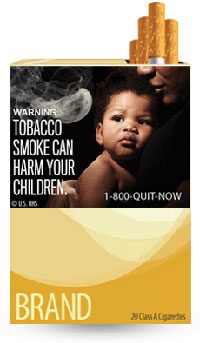Four major tobacco companies filed a lawsuit in federal court earlier this month to fight the Food and Drug Administration’s infamous new cigarette warning labels — those half-pack, graphic images of rotting lungs and teeth, dead bodies and presumed smokers on respiratory machines. Anyone who’s looked at the images — due to appear on packs in September 2012 — couldn’t be surprised that Big Tobacco balked.
The companies are arguing that the new warnings violate their First Amendment rights to, in essence, not be forced to carry gross pictures designed to discourage sales on their products.
That logic, especially in a post-Citizens United world, sounds ripe for a headline from The Onion: Cigarettes have free-speech rights, too. The Campaign for Tobacco-Free Kids shrugged off the suit, calling it “frivolous.”
First Amendment scholars, though, say this legal battle has been years in the making and raises real questions about what happens when the government’s interest in promoting public health collides with the Constitution.
“This is anything but frivolous,” said Richard Kaplar, a commercial speech expert with the Media Institute. “Quite the contrary.”
Considerable social science and psychology research has gone into determining whether such labels are effective and how best to prod people into making smart decisions for their health. And many countries outside the U.S., such as Canada, have opted for even more gross warnings that they say have curbed smoking. But all of those findings are moot if the Supreme Court strikes down the whole graphic-labeling strategy.
“To me, it’s just a classic case of compelled speech and government overregulation, and I think it does infringe on tobacco companies’ First Amendment rights, which may not be a popular opinion,” said David Hudson, a scholar with the First Amendment Center at Vanderbilt. “The sheer size of these ads, and the graphic nature of them, if you think about it, it’s an advertiser being forced to put ‘don’t buy this product’ on the product.”
That tobacco companies have First Amendment rights is not in question. “Commercial speech,” or advertising copy, however, has long been a second-class citizen in the First Amendment family.

Miller-McCune’s Washington correspondent Emily Badger follows the ideas informing, explaining and influencing government, from the local think tank circuit to academic research that shapes D.C. policy from afar.
“Historically, it’s been seen to somehow be of lesser value because it involves commercial transactions,” Kaplar said. “It was thought that if you’re just talking about ‘I’m trying to sell you something,’ that’s not as important as if we’re having a discussion about democracy, or this candidate or that candidate, the big issues of the day.”
And so government regulation of commercial speech is measured against a four-part test that dates to a 1980 Supreme Court case, Central Hudson Gas & Electric Corp. v. Public Service Commission of New York. The test poses four questions: Is the speech lawful, truthful and not misleading? Does the government have a substantial interest in regulating it? Does the regulation directly advance the government’s interest? And is the regulation a narrowly tailored and reasonable fit for doing that?
The fight over the FDA’s cigarette labels could touch on all four. Tobacco companies will certainly argue that their existing packaging is lawful and truthful. But, said Robert O’Neil, director of the Thomas Jefferson Center for the Protection of Free Speech, the government could counter that it’s misleading not to show people shocking images of what cigarettes can do to your lungs.
The government will also undoubtedly argue that it has a substantial interest in protecting public health (and paying for the health care costs of people who wind up with lung cancer). But the last two questions are trickier. Will these images actually discourage smoking and enhance public health, as the government hopes they will? Research on this question is mixed. And even if the images were effective, couldn’t the government warn people about cigarettes with a less drastic tool — like, say, the messages already in use?

This last point is the most compelling for armchair legal scholars: Is there a constitutional line to be drawn somewhere between a text-based surgeon general’s warning and a full-color photo of a smoking man with a hole in his throat?
“That’s a fascinating distinction,” O’Neil said. “When this issue gets into court, I’m sure there will be some very strong arguments on both sides, because it basically is open-ended.”
Still, he and Kaplar both come down alongside Hudson: The Tobacco companies are probably in the right here. Kaplar believes that they willingly agreed to some restrictions on their rights to keep the peace — and continue selling their products — in the wake of the 1998 “Master Settlement Agreement” with the states. That settlement did away with cartoon pitchmen like Joe the Camel and other ad tactics that critics said targeted children.
These graphic new labels, though, have upended that balance.
“To force someone to put that on their product is really going into a new territory, across a line that hasn’t been crossed before,” Kaplar said. “Probably the government thought they could get away with it, that maybe tobacco companies wouldn’t put up much of a fight since they’ve been relatively complacent the last several years.”
But as fascinating as this case is, O’Neil doesn’t expect the outcome to impact many other government health campaigns. In many ways, tobacco has always been unique.
“Regulating the speed at which an automobile can be driven, that’s handled by speed limits,” O’Neil said. “Or if you’re worried about sugar content in children’s cereal, regulate the sugar content.”
Tobacco, though — as long as it remains a legal product — doesn’t really have such an analogous government solution.
“I’ve thought a lot about the alternative,” O’Neil said, “and I have not really ever been able to come up with anything.”
Sign up for the free Miller-McCune.com e-newsletter.
“Like” Miller-McCune on Facebook.
Follow Miller-McCune on Twitter.
Add Miller-McCune.com news to your site.





